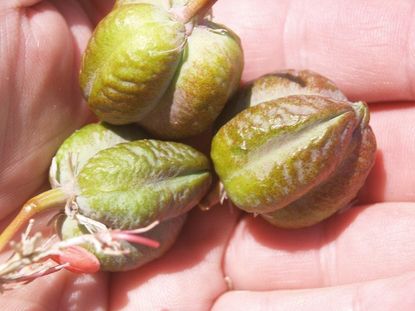Seed Pods Are Soggy - Why Are My Seed Pods Mushy

When you go out to collect seeds from the plants at the end of the flowering season, you may find that the seed pods are soggy. Why is this and are the seeds still okay to use? Learn more about whether drying out wet seeds is possible in this article.
Why are My Seed Pods Mushy?
There may be several reasons for soggy seed pods, such as a sudden shower or freeze. Seeds can deteriorate very fast in such wet and damp conditions. Insect infestations may also result in soggy seed pods that either rot or sprout prematurely.
Can I Still Use Seeds from Wet Pods?
In spite of the wetness, the seeds in the pods may be intact. If they are mature, you have a very good chance of saving them. Those with thick seed coats are often impervious to moisture. However, dampness is the number one enemy of seeds, so you have to act immediately to save what you can.
What to Do When Seed Pods are Soggy
You have to check the condition of the seeds first. Open the pods over a kitchen towel. You can use tweezers to ease out the seeds from the mushy pods. If they are still green and soft, they are not mature. Tan or black seeds hold more promise. After removing all the debris from the seeds, check them for moisture damage. Moisture can typically cause damage in the following ways: Sprouting - If the seeds are mature enough, moisture may soften their coats and initiate germination. If a whitish root is poking out of the seed, it has already sprouted. Enlarged seeds and cracks on the seed coat also indicate sprouting. You cannot dry and store seeds that are in different stages of germination. However, you can plant them immediately to get new plants. If the seeds are precious, you can take the trouble of growing the seedlings in a cold frame until the weather is right for them to be planted outside. Rotting - If the seeds are as mushy as the seed pods, they have rotted and must be discarded. You can wash the seeds in a bowl of water and drain them in a coffee filter. Check each one to see if any are firm and separate them from the rotten ones. Rotting is bacterial damage, and it can affect healthy seeds if they are kept together. Wash the good ones in a dish with hydrogen peroxide. Dry on paper towels and store separately from other seeds. If you are lucky, many of them may germinate when you plant them later. Molding - Growth of mold is another reason for seeds inside wet pods to spoil. You may see white, gray, or black fuzz or powdery growth on the seeds. Discard moldy seeds immediately. It is not advisable to try and save healthy seeds from the lot because mold spores can survive drying. They may contaminate the seed trays and spoil the seedlings too. Insects - If the seed pod has an infestation of aphids or such other pests, it may cause wetness. If the seeds inside are mature, these critters may not have caused any damage. Wash them well and store when dry.
Drying Out Wet Seeds
Wet seeds taken out of the seed pods should be washed to remove all traces of the mushy remnants. Filter out the seeds and lay them on several layers of tissue paper. Cover them with more paper and gently press to remove excess moisture. If the seeds are hard and mature, you can safely dry them and store them for future use. Dry thoroughly in the shade or under a fan. Store seeds in paper covers or glass bottles.
Gardening tips, videos, info and more delivered right to your inbox!
Sign up for the Gardening Know How newsletter today and receive a free download of our most popular eBook "How to Grow Delicious Tomatoes."